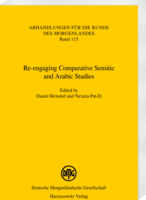|
|
more titles of the subject:
Download:
Please note: With adding digital Products to your cart
the payment will be handled via PayPal. The download will be provided after the payment is confirmed. The present volume has largely emerged from a section on “Comparative Semitic and Arabic studies” at the conference “Horizons of Islamic Theology”, which was held at Goethe University Frankfurt in September 2014. It comprises five contributions and covers an area reaching from general and comparative Afro-Asiatic syntax to South Arabian phonology to diachronic and synchronic Arabic linguistics.
Ahmad Al-Jallad explores the diagnostic features the languages commonly bundled as Ancient North-Arabian and discusses their relationship with Arabic. Daniel Birnstiel investigates the meaning of the Qur’anic term mubīn from a synchronic linguistic perspective. Lutz Edzard discusses various functions of the Arabic accusative and demonstrates how they can be analyzed as marked nominatives from a comparative Afro-Asiatic and Semitic perspective. Phillip Stokes traces the history of the common Arabic dialectal relative marker illī and he adduces evidence suggesting a derivation from the definite article *al followed by a plural demonstrative *ʾulay. Janet Watson and Abdullah Musallam al-Mahri look at word stress in Mehri from the perspective of stratal optimality theory and show how the rules determining Mehri word stress may be analyzed as combinations of lexical stress and the interaction of constraints. |
|||||||||||||||||||||||||||||||||||||||||






